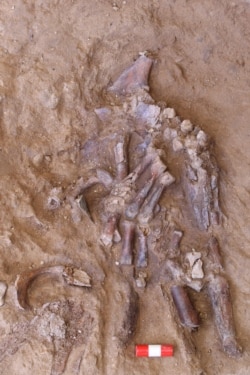Neanderthals may have buried and honored their dead, a new study suggests. The early human ancestors may have even used flowers in burials. Scientists recently announced their discovery in the publication Antiquity.
The scientists found the bones of an adult in Shanidar Cave, in the Kurdistan area of northern Iraq. The Neanderthal, called Shanidar Z, is believed to have lived up to 70,000 years ago. The individual was possibly in his or her 40s or 50s. Scientists do not yet know the sex of the individual.
The cave where the bones were found is already famous in archaeology. In 1960, archaeologist Ralph Solecki discovered the remains of 10 Neanderthals - seven adults and three children.
At the time, small amounts of flower pollen were found in soil around the remains. The discovery led Solecki to propose that Neanderthals buried their dead and even had funeral ceremonies with flowers.
Critics later doubted the “flower burial” explanation. They argued that the pollen could have been modern contamination from people, animals or insects.
Shanidar Z’s bones were found in soil containing ancient pollen and plant remains, suggesting the possibility of flower burials.
Scientists are now further examining the materials.
Scholars have argued for years about whether Neanderthals buried their dead with funeral ceremonies.
Emma Pomeroy studies ancient humans at the University of Cambridge. She was the lead writer of the recent study.
She said that what is important about the burial is the aim or purpose behind it. “You might bury a body for purely practical reasons, in order to avoid attracting dangerous scavengers,” she said.
Pomeroy added that if more is done “it is important because that indicates more complex, symbolic and abstract thinking, compassion and care for the dead, and perhaps feelings of mourning and loss.”
Shanidar Z appears to have been placed in an area cut into the soil. The area has a group of four individuals.
Graeme Barker, a University of Cambridge archeologist, helped write the study. He said the cave may have been used as a burial place for a long period of time. “…It seems clear that Shanidar was a special place, with bodies being placed just in one part of a large cave,” he said.
Neanderthals were more strongly built than modern humans, or Homo sapiens. They lived in Eurasia from about 400,000 years ago until around 40,000 years ago. They then disappeared after modern humans became established.
Modern non-African human populations are believed to carry small amounts of Neanderthal genetic material known as DNA.
I’m John Russell.
Will Dunham reported on this story for Reuters. John Russell adapted it for Learning English. Mario Ritter, Jr. was the editor.
________________________________________________________________
Words in This Story
Neanderthal – n. a type of early human being that existed very long ago
archaeology – n. science that deals with past human life and activities by studying the bones, tools, etc., of ancient people
pollen – n. the very fine usually yellow dust that is produced by a plant and that is carried to other plants of the same kind usually by wind or insects so that the plants can produce seeds
contamination – n. to make (something) dangerous, dirty, or impure by adding something harmful or undesirable to it
practical -- adj. logical and reasonable in a particular situation
scavenger -- n. an animal that eats waste, junk, dead animals, etc.
indicate -- v. to show that (something) exists or is true
abstract – adj. relating to or involving general ideas or qualities rather than specific people, objects, or actions of art : expressing ideas and emotions by using elements such as colors and lines without attempting to create a realistic picture
We want to hear from you. Write to us in the Comments Section.








